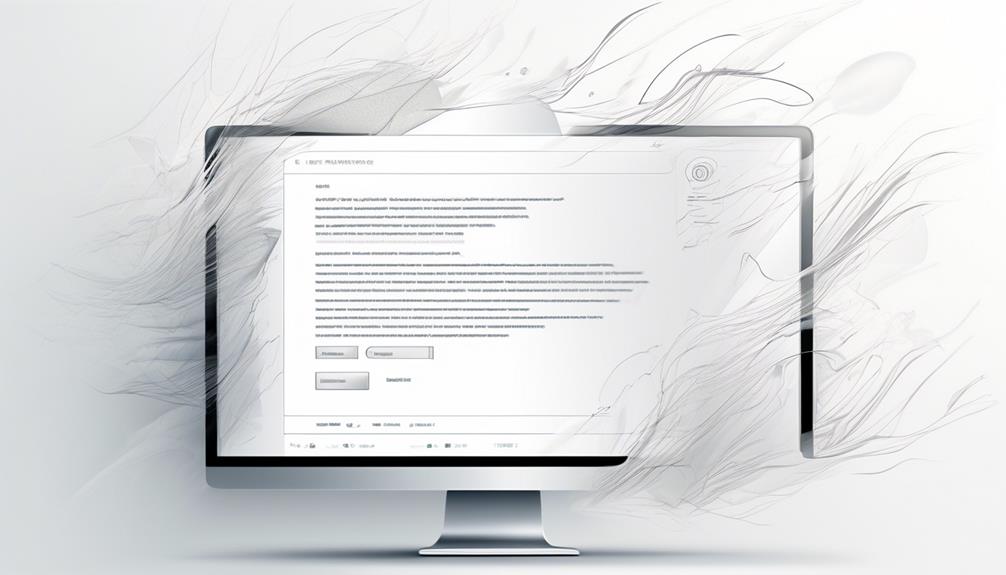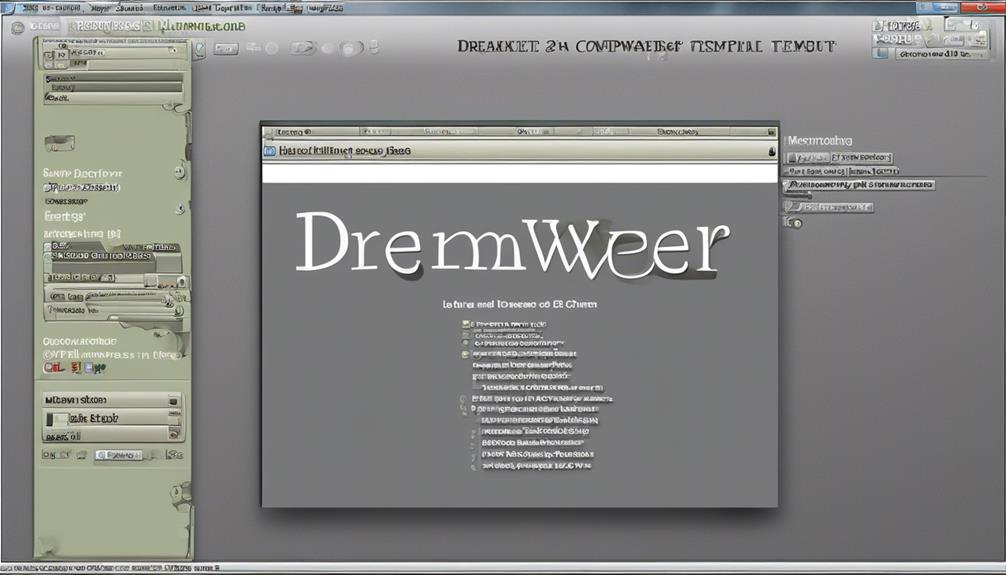Mastering the craft of composing a professional email while upset is akin to balancing on a tightrope during a storm.
We've all been there – feeling the surge of frustration and needing to address an issue head-on. But how do we convey our discontent without coming across as unprofessional or disrespectful?
Well, the answer lies in the balance between expressing our concerns assertively while maintaining a tone of professionalism and respect.
So, how exactly do we strike this delicate balance?
Join us as we unravel the key strategies for crafting an angry email that commands attention and elicits the desired response.
Key Takeaways
- Clearly state the problem and desired outcomes in your angry email.
- Use professional language and clear communication strategies to convey your message effectively.
- Maintain composure and respect, avoiding personal attacks or hostile language.
- Review your email for clarity and tone, ensuring a balanced approach that acknowledges the issue without being overly aggressive or apologetic.
Understanding the Purpose of Your Email
How can we ensure that the main reason for our email is clearly and effectively conveyed?
When writing an angry email professionally, it's vital to understand the purpose behind our communication. We must identify the core reason for the email and ensure that our message is tailored to that specific purpose. By focusing on the primary objective, we can avoid diluting the message with unnecessary information or emotions.
Clearly outlining our expectations and desired outcomes within the email is crucial for maintaining a professional tone and achieving a constructive resolution. It's essential to leverage our communication skills to convey our points effectively, even when addressing challenging situations.
Working together to find a solution requires us to communicate with clarity and precision, avoiding any ambiguity that could hinder the understanding of our email's purpose. Reviewing and revising the email is equally important to confirm that the purpose is effectively communicated, aligning with the intended objective of the communication.
This approach ensures that our message is received as intended, fostering a productive and respectful exchange.
Managing Your Emotions Effectively

Before we hit send on that angry email, let's take a step back and assess our emotions.
It's important to practice some deep breathing or relaxation techniques to calm ourselves down.
We need to communicate our feelings assertively and respectfully, avoiding blaming language, in order to address the root issue effectively.
Emotion Control Techniques
To effectively manage your emotions, it is essential to practice deep breathing exercises and engage in positive self-talk to regain control and approach the situation with clarity and composure. It's important to take a step back and assess the situation from a neutral perspective before reacting. Engaging in physical activity or taking a short walk can help release built-up tension and frustration. Seeking support from a trusted friend, mentor, or professional can provide valuable insights and perspective on the situation. Here's a table to summarize emotion control techniques:
| Emotion Control Techniques |
|---|
| Practice deep breathing exercises |
| Use positive self-talk |
| Assess the situation from a neutral perspective |
| Engage in physical activity |
| Seek support from a trusted individual or professional |
These techniques can help you manage your emotions effectively, especially when dealing with anger while drafting a professional email.
Professional Language Usage
In our professional communication, it's crucial to convey our message with clarity and respect, ensuring that our emotions are managed effectively. Professional language usage is essential for communicating effectively while maintaining a high level of professionalism.
It's important to use correct grammar and concise, understandable language to convey our message clearly. By avoiding ambiguous or overly formal language, we can ensure that our communication is received positively and our intentions are understood.
When using professional language, it's vital to maintain a respectful and positive tone, even when addressing challenging or frustrating situations. This level of professionalism not only fosters better relationships but also helps to prevent misunderstandings.
Clear Communication Strategies
Our emphasis on professional language usage underscores the importance of managing our emotions effectively in clear communication strategies. When working together, it's crucial to communicate your frustrations in a professional manner. To achieve this, consider the following strategies:
- Active Listening: Actively listen to the concerns of the other party before expressing your own frustrations. This demonstrates empathy and can pave the way for a more constructive conversation.
- Use 'I' Statements: When expressing your frustrations, use 'I' statements to take ownership of your feelings without placing blame. This can help prevent the other party from becoming defensive.
- Offer Constructive Solutions: Instead of solely focusing on the problem, offer constructive solutions to address the issues at hand. This proactive approach can shift the conversation from venting to problem-solving.
Setting the Tone Appropriately

When setting the tone for an angry email, it's crucial to maintain a professional and respectful demeanor, even when expressing frustration.
We should aim to be direct and clear in addressing the specific issue at hand, avoiding harsh language or personal attacks.
Using professional language and keeping the communication concise will help ensure that our message is effectively delivered without unnecessary emotional language.
Tone and Respect
We should strive to convey our frustration with a respectful and professional tone while avoiding aggressive language in our email communication.
When addressing tone and respect, it's crucial to acknowledge our emotions and choose our words carefully.
It's important to avoid aggressive or hostile language and focus on providing constructive criticism rather than resorting to personal attacks.
Additionally, balancing the expression of frustration with understanding and empathy towards the recipient's perspective can facilitate conflict resolution and improve communication.
Direct and Clear
After maintaining a respectful and professional tone in our email communication, it's essential to pivot to the subtopic of being direct and clear in conveying our concerns.
When writing an angry email, it's crucial to be direct and clear about the issue at hand. Start with a clear and concise statement of the problem without sugar-coating. Use neutral and professional language, avoiding emotional rhetoric.
Break down each detail into separate sentences for clarity and emphasis. Ensure that your point is clearly heard and state your expectations for resolution. It's important to stay focused on the subject matter and delete anything unrelated to the issue.
Professional Language
Using a neutral and respectful tone is essential when expressing frustration in professional communication. When drafting an angry email, it's crucial to consider the professional language used to convey your message effectively.
To maintain a respectful tone, consider the following:
- Choose words carefully: Opt for neutral and non-inflammatory language to express your concerns.
- Acknowledge the recipient: Show respect and consideration for the recipient's perspective, even if you disagree.
- Offer solutions: Focus on problem-solving rather than venting frustration, and clearly state your expectations for a resolution.
Crafting a Clear and Direct Message

At the outset of the email, it is crucial to clearly and neutrally articulate the problem or issue at hand, ensuring that the message is direct and focused. When crafting an angry email, it's essential to maintain a clear and direct message to effectively communicate your concerns. Utilizing a structured format can aid in clearly conveying your points. Consider breaking down the details into specific sentences, ensuring each addresses a different aspect of the issue. To maintain a clear and direct message, it's important to remove any unrelated information that may dilute the focus on the subject. Additionally, clearly state your expectations and desired outcomes. This will provide the recipient with a clear understanding of what you aim to achieve through the communication. The following table illustrates how to structure your message for clarity and focus:
| Point | Example |
|---|---|
| Clearly state the problem | "I am writing to address the ongoing issue…" |
| Use neutral language | "I was disappointed to learn that…" |
| Separate details into specific sentences | "Firstly, the lack of response is concerning." |
| State expectations and desired outcomes | "I expect a resolution to this matter." |
| Remove unrelated information | "This issue is unrelated to our previous discussions." |
Crafting a clear and direct message in an angry email is essential to ensure that your concerns are effectively communicated.
Offering Constructive Solutions

As we address the issue at hand in the angry email, it's important to pivot towards offering constructive solutions that focus on resolving the problem and promoting a collaborative approach.
When offering constructive solutions in response to the issue at hand, it's essential to consider the following:
- Identify the Problem and Propose Solutions: Clearly articulate the problem and suggest specific solutions, demonstrating a proactive approach towards resolution.
- Promote a Collaborative Approach: Frame the feedback in a manner that encourages teamwork and improvement, fostering a positive and solution-oriented environment.
- Encourage Open Dialogue and Alternative Perspectives: Emphasize the importance of open communication and the exploration of diverse viewpoints to find mutually beneficial outcomes, thus promoting a culture of understanding and cooperation.
Encouraging Open Communication

To foster a culture of open communication, we prioritize creating an environment where all team members feel empowered to express their thoughts and opinions. Encouraging open communication is essential for maintaining a healthy and productive work environment. By promoting active listening and providing opportunities for everyone to contribute to discussions, we ensure that diverse viewpoints are acknowledged and respected. To further support open communication, it's important to foster an environment where feedback is welcomed and valued, even when it involves differing opinions. Establishing regular check-ins or meetings can address any concerns and ensure open lines of communication. Additionally, leading by example by being open to receiving feedback and actively seeking input from others sets the tone for the entire team.
| Encouraging Open Communication | ||
|---|---|---|
| Promote active listening | Establish regular check-ins | Lead by example |
| Provide opportunities for all | Foster environment for feedback | Actively seek input from others |
| Encourage diverse viewpoints | Address concerns openly |
Encouraging open communication not only enhances team dynamics but also minimizes the likelihood of resorting to writing an angry email. Open communication fosters understanding and collaboration, reducing the potential for misunderstandings or conflicts to escalate.
Incorporating Positive Language

In our communication, we can effectively incorporate positive language to convey our perspectives and address concerns with a constructive and respectful approach.
When writing an email, it's crucial to express feelings of anger or frustration using phrases like 'I believe,' 'I feel,' or 'It seems' to avoid sounding accusatory.
Additionally, take the time to offer solutions and suggestions for improvement rather than solely focusing on the negative aspects.
By acknowledging the efforts and positive aspects of the recipient's work or previous accomplishments, we can maintain a positive and respectful tone throughout the email, even when expressing dissatisfaction.
It's important to end the email on a positive note, expressing gratitude or appreciation for the recipient's efforts, to ensure the overall tone remains constructive and respectful.
Incorporating positive language not only helps in addressing concerns but also fosters an environment of open communication and collaboration.
Conveying Professionalism Through Language

After incorporating positive language to address concerns in our previous communication, we now focus on conveying professionalism through language, ensuring that our message is delivered neutrally and assertively.
When dealing with a difficult situation, it's essential to collect your thoughts before crafting your email. Be specific and articulate, breaking down each detail into separate sentences for clarity. This approach will help to ensure that the recipient fully understands your perspective.
Additionally, stating your expectations clearly and assertively without resorting to overly emotional phrasing will convey professionalism. It's important to work together to find a resolution, so maintain a focused approach to ensure that the email content is directly related to the subject at hand.
Avoid sarcasm and hostile language, as these can undermine the professionalism of your message. Instead, strive to offer constructive criticism and positive feedback where appropriate.
Reviewing for Clarity and Tone

Upon reviewing the email, we aim to ensure its clarity and tone align with our professional standards. It's crucial that the message is clear and concise, avoiding unnecessary details that could dilute the core message.
We must strike a balanced tone that acknowledges the issue at hand without being overly aggressive or apologetic. This involves maintaining professionalism and formality throughout the email, using proper greetings and respectful language. It's important to convey a positive and respectful tone, steering clear of rude or timid language that could detract from the message.
Additionally, we need to ensure that the language used is direct and unambiguous, effectively communicating the purpose and expectations to the recipient. By carefully reviewing the email for clarity and tone, we can ensure that it aligns with our professional standards and effectively conveys our message.
Recognizing Common Triggers for Angry Emails

As we navigate through the process of composing angry emails professionally, it's crucial to recognize the common triggers that often lead to emotional responses.
By pinpointing these triggers, we can better understand the underlying causes of our frustration and address them with a level head.
It's important to stay aware of these triggers to prevent them from influencing the tone and content of our emails.
Common Triggers
Recognizing common triggers for angry emails is essential for effectively managing and addressing the underlying issues.
When individuals feel misunderstood or not listened to, they may resort to crafting angry emails to vent their frustrations.
Perceived incompetence or mistakes by others can also trigger negative feelings, leading to the need to express their dissatisfaction through email.
Additionally, unmet expectations or broken promises often prompt individuals to resort to angry emails as a way to communicate their disappointment.
Understanding these common triggers can help us anticipate and address the root causes of anger in email communications, allowing us to respond with empathy and professionalism.
Emotional Response
Understanding the emotional triggers behind angry emails allows us to navigate and diffuse potentially volatile situations with empathy and professionalism. Emotional responses play a significant role in the decision to send an angry email. When feeling defensive, individuals may react emotionally and impulsively, leading to the drafting of an angry email.
It's crucial to recognize when emotions are guiding our actions and to take a step back to assess the situation objectively. Professionalism should always be at the forefront of our response, even when emotions are running high. By acknowledging our emotional response and choosing to address the issue calmly and respectfully, we can prevent the escalation of conflicts and maintain positive working relationships.
Recognizing and managing our emotional triggers is essential for handling angry emails with grace and professionalism.
Emphasizing the Importance of Professional Communication

Emphasizing the importance of professional communication is fundamental in cultivating respect and fostering positive relationships in the workplace. When it comes to dealing with an angry email, it's crucial to remember the significance of professional communication. Here are some key points to consider:
- Respect and Consideration: Professional communication demonstrates respect and consideration for others, even in challenging situations like responding to an angry email. It's essential to maintain a composed and respectful tone throughout the correspondence.
- Building Positive Relationships: Effective professional communication helps to build and maintain positive and constructive relationships. When addressing an angry email, it's important to focus on finding solutions and maintaining a professional demeanor.
- Clarity and Understanding: Professional communication fosters clarity and understanding in interactions. When responding to an angry email, it's important to clearly articulate points and seek to understand the underlying concerns.
In the context of an angry email, it's important to remember that professional communication not only de-escalates the situation but also sets a standard for respectful and constructive dialogue.
Can I Use Techniques from Writing a Persuasive Email in an Angry Email Professionally?
When dealing with negative emotions in professional emails, utilizing writing persuasive email tips can be helpful. While the tone may differ, the principles of effective communication remain the same. By acknowledging the recipient’s feelings, presenting a clear argument, and maintaining professionalism, you can navigate difficult situations with tact.
Frequently Asked Questions
How Do You Express Frustration Professionally?
We express frustration professionally by acknowledging the issue, maintaining composure, and focusing on finding a solution.
It's essential to communicate clearly and respectfully, addressing the problem directly without assigning blame. By using concise and understandable language, we can convey our dissatisfaction while remaining diplomatic.
Understanding the audience's desire for mastery, we aim to articulate our frustration in a strategic and composed manner, emphasizing the objective of resolving the issue.
How Do You Say You Are Angry Politely?
We can express anger politely by using a calm and assertive tone, clearly stating our feelings without being confrontational.
It's important to focus on the issue at hand, offer potential solutions, and maintain a respectful demeanor.
By acknowledging our emotions while staying professional, we can effectively communicate our dissatisfaction without causing unnecessary conflict.
This approach can help foster constructive dialogue and resolution.
How Do You Professionally Respond to an Angry Email?
We've all been there – receiving an angry email can be like a surprise party you didn't want.
But fear not, we can handle this with finesse. It's essential to stay calm, acknowledge the sender's concerns, and respond professionally.
We should strive to de-escalate the situation, provide a solution, and maintain a respectful tone.
Our goal is to turn the angry email into a productive conversation.
How Do You Send a Strongly Worded Email?
We send a strongly worded email by clearly stating the problem, using specific and neutral language. Each detail is broken down into separate sentences to ensure our point is heard.
We stay focused, deleting anything unrelated, aiming for a positive impact on the recipient's motivation to improve.
It's crucial to maintain a professional and polite tone for healthy connections with coworkers and clients.
We also consider if email is the best method for communication.
Conclusion
In the world of professional communication, our words carry weight and power. Let's strive to be the calm in the storm, the lighthouse in the darkness. Our emails should be a beacon of professionalism, guiding others to solutions and understanding.
Let's choose our words carefully, with empathy and clarity, to ensure our message is heard and our relationships remain strong.










